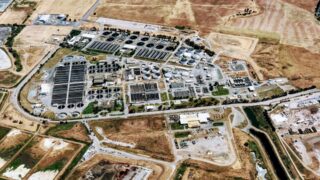Designing a MBBR plant? Transcend can help
What is a MBBR?
MBBR stands for Moving Bed Biofilm Reactor technology. It is a type of biological treatment for municipal and certain industrial wastewaters, where the bugs doing the job are sitting on floating plastic carriers inside the bioreactors. The technology was developed in the 1980s-1990s with the goal of improving the retention of microbes in the bioreactors which has many beneficial effects from a performance perspective.
A good starting point on collecting more information on MBBRs is the Moving bed biofilm reactor wikipedia site which has a good set of references for the interested reader, and of course there are always the detailed textbooks like this and this.
What is the Transcend Design Generator?
The Transcend Design Generator (TDG) is a software-as-a-service platform helping you generate preliminary designs for wastewater treatment plants. It supports both new installations and plant extensions as well.
It is available at dg.transcendh2o.com, where you can register for free. You’re able to select the options most feasible for you and hit the ‘Create a new project’ button to start configuring your new design.
What data do I need to start the design?
The data required for a design depends on the actual project. For greenfield projects, influent flow and composition data are required, effluent limits are key parameters too. In addition to this, information on the site is also vital.
For plant upgrades/extensions, data on the existing assets (volumes, surface areas, condition, etc.) are also important. Let’s look at these in some more detail!
Influent flow data
Roughly speaking, what largely affects your plant size is the characteristic average and peak influent flows. Each of these quantities has its role in the design: usually, average flows are used when average consumption data are calculated (for energy, chemicals, etc.), various peak numbers are used for hydraulic design considerations, wet peaks for stormwater management, etc.
The TDG offers entering the following influent flow-related data:

Peak flows are used in addition to classic hydraulic sizing procedures to check the effect of dynamic loading conditions on the effluent quality by dynamic hydraulic and biokinetic models as well (the importance of these checks was demonstrated in a recent post from Kim Sorensen).
The good thing is that if you do not have detailed peak data, the TDG estimates them for you based on the average flow and the geography. Though such database-backed estimations should be considered with some care, it is still better to use such numbers in the preliminary design phase than neglecting the effect of dynamic input flows.
Influent composition data
TDG offers entering the composition data as detailed in the figure below. In the generic TDG version, these are considered as daily average values for dry weather conditions. Nitrogen and phosphorus content can either be configured on a TKN/TP basis, or on an ammonia/orthophosphate basis too.

Where is my influent fractionation?
If you have ever used a dynamic WWTP simulator, you are aware of the importance of the influent characterization and fractionation, i.e., the process of dividing the usually measured quantities like COD or TSS into the state variables of the dynamic model working in the background. In these simulators, there are default fractions used during the fractionation step.
These fractions work well most of the time, and if not, then users are allowed to fine-tune them, and simulators provide manual tools to change fractionation. These tools usually support a simple trial-and-error workflow, i.e., the process engineer’s experience is the only guide to set up a good fractionation in a reasonable amount of time.
In the TDG the system provides an automated fractionation, which, if the default fractions provide suboptimal results, takes care of an automatic optimal fine-tune to achieve the best matching results between measured numbers and model data.
In the next part of the series, we will look behind the scenes and reveal how the automatic fractionation tool works, and continue reviewing the preliminary design process à la TDG.







